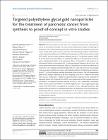| dc.contributor.author | Spadavecchia J. | |
| dc.contributor.author | Movia D. | |
| dc.contributor.author | Moore C. | |
| dc.contributor.author | Maguire C.M. | |
| dc.contributor.author | Moustaoui H. | |
| dc.contributor.author | Casale S. | |
| dc.contributor.author | Volkov Y. | |
| dc.contributor.author | Prina-Mello A. | |
| dc.date.accessioned | 2016-03-31T12:30:08Z | |
| dc.date.available | 2016-03-31T12:30:08Z | |
| dc.date.issued | 2016 | |
| dc.identifier.citation | Spadavecchia J., Movia D., Moore C., Maguire C.M., Moustaoui H., Casale S., Volkov Y., Prina-Mello A., 'Targeted polyethylene glycol gold nanoparticles for the treatment of pancreatic cancer: From synthesis to proof-of-concept in vitro studies', International Journal of Nanomedicine, 11, 2016, 791, 822 | |
| dc.identifier.uri | http://hdl.handle.net/2262/76122 | |
| dc.description.abstract | The main objective of this study was to optimize and characterize a drug delivery carrier for doxorubicin, intended to be intravenously administered, capable of improving the therapeutic index of the chemotherapeutic agent itself, and aimed at the treatment of pancreatic cancer. In light of this goal, we report a robust one-step method for the synthesis of dicarboxylic acid-terminated polyethylene glycol (PEG)-gold nanoparticles (AuNPs) and doxorubicin-loaded PEG-AuNPs, and their further antibody targeting (anti-Kv11.1 polyclonal antibody [pAb]). In in vitro proof-of-concept studies, we evaluated the influence of the nanocarrier and of the active targeting functionality on the anti-tumor efficacy of doxorubicin, with respect to its half-maximal effective concentration (EC50) and drug-triggered changes in the cell cycle. Our results demonstrated that the therapeutic efficacy of doxorubicin was positively influenced not only by the active targeting exploited through anti-Kv11.1-pAb but also by the drug coupling with a nanometer-sized delivery system, which indeed resulted in a 30-fold decrease of doxorubicin EC50, cell cycle blockage, and drug localization in the cell nuclei. The cell internalization pathway was strongly influenced by the active targeting of the Kv11.1 subunit of the human Ether-�-go-go related gene 1 (hERG1) channel aberrantly expressed on the membrane of pancreatic cancer cells. Targeted PEG-AuNPs were translocated into the lysosomes and were associated to an increased lysosomal function in PANC-1 cells. Additionally, doxorubicin release into an aqueous environment was almost negligible after 7 days, suggesting that drug release from PEG-AuNPs was triggered by enzymatic activity. Although preliminary, data gathered from this study have considerable potential in the application of safe-by-design nano-enabled drug-delivery systems (ie, nanomedicines) for the treatment of pancreatic cancer, a disease with a poor prognosis and one of the main current burdens of today�s health care bill of industrialized countries. | |
| dc.language.iso | en | |
| dc.relation.ispartofseries | International Journal of Nanomedicine | |
| dc.relation.ispartofseries | 11 | |
| dc.subject | Antibody-drug conjugate | |
| dc.subject | Doxorubicin | |
| dc.subject | HERG1 | |
| dc.subject | Pancreatic cancer | |
| dc.subject | PEGylated gold nanoparticles | |
| dc.subject | Potassium channel targeting | |
| dc.title | Targeted polyethylene glycol gold nanoparticles for the treatment of pancreatic cancer: From synthesis to proof-of-concept in vitro studies | |
| dc.type | Journal Article | |
| dc.status.refereed | Yes | |
| dc.identifier.peoplefinderurl | http://people.tcd.ie/yvolkov | |
| dc.identifier.doi | 10.2147/IJN.S97476 | |
| dc.rights.ecaccessrights | openAccess | |
| dc.format.extentpagination | 791 | |
| dc.format.extentpagination | 822 | |




